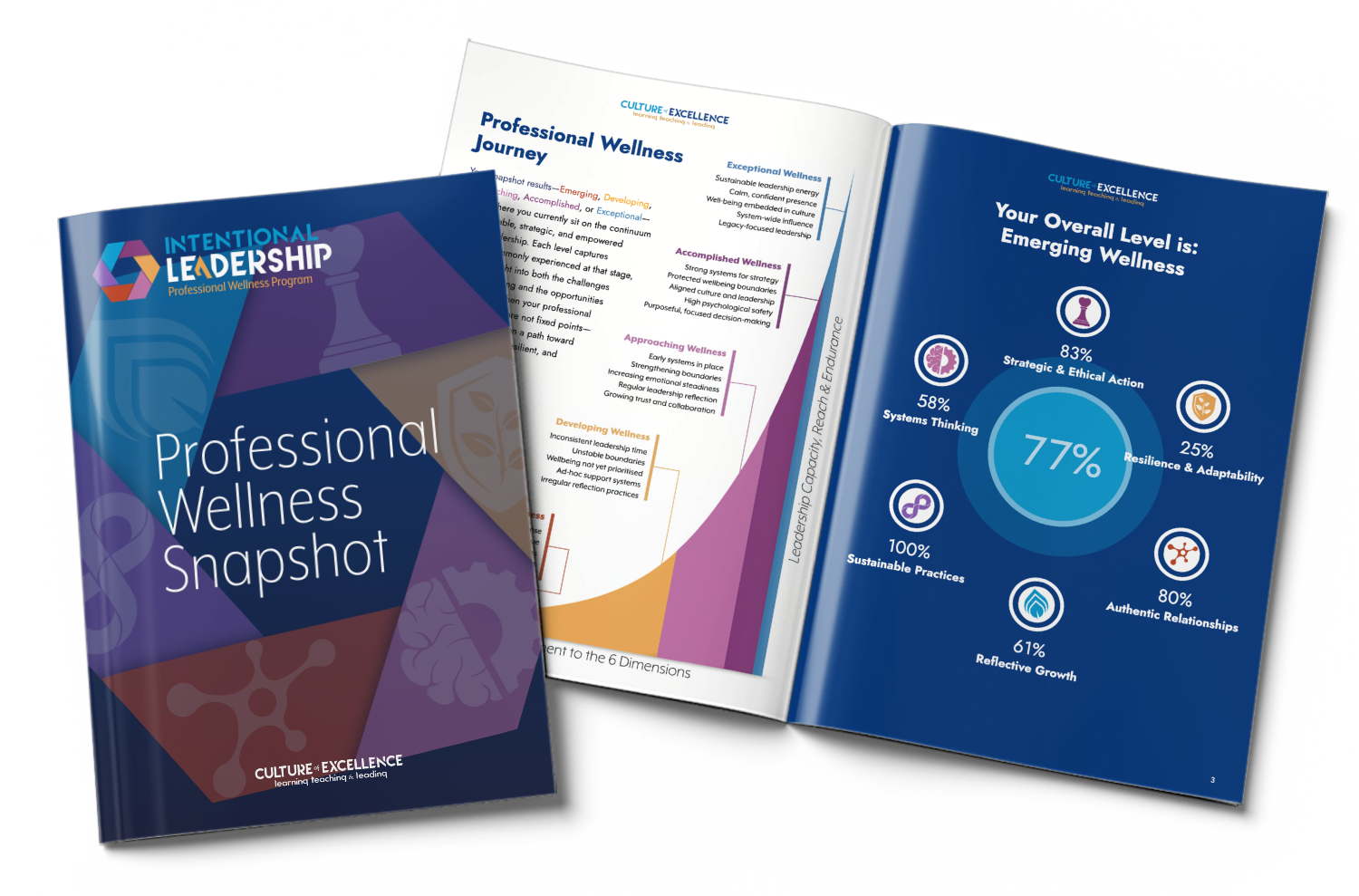
The Invisible Leader
When Showing Up Means More Than Being in Charge
This video discusses why presence is more than just physical visibility for a school leader. There are four invisible shifts that can quietly erode your influence, and we'll talk about them here. You'll also discover how to reclaim trust and momentum through everyday connection, and learn low-barrier practices that rebuild relational presence.
Where have you been present, but not felt?
Want to Lead With Steadiness—Not Strain?
Join our FREE Professional Wellness Workshop—a live session where we explore all six dimensions and help you refocus on what really sustains school leadership.

The Invisible Leader
When Showing Up Means More Than Being in Charge
In every school I visit, I meet leaders who are technically everywhere. Their names sit atop every decision. Their fingerprints are on every policy. Their calendar is packed to the edges.
And yet, when I ask staff or students what it feels like to be led by them, the response is… vague.
It’s not that these principals aren’t doing the work. It’s that they’ve become invisible in the places that matter most. This article explores what happens when leadership presence fades—and how to reclaim it in ways that rebuild trust, culture, and influence.
The Disappearing Act of Modern Leadership
Today’s principals are navigating an unprecedented squeeze on their time, energy, and visibility. According to the 2023 Australian Principal Health and Wellbeing Survey, the top two sources of stress for leaders are the sheer volume of work(8.19/10) and a lack of time to focus on teaching and learning (7.91/10).
What disappears first under this pressure isn’t paperwork. It’s presence. Emotional, relational, and cultural visibility gets sacrificed for efficiency. Leadership becomes something you deliver—not something you embody.
Leadership clarity isn't just what we say. It's how we make people feel about what we say.
Invisibility isn’t just about being absent from the staffroom. It’s when your leadership is no longer felt. You’re consulted late. Copied in, but never engaged. Decisions are implemented without your influence.
And over time, your cultural authority—your trust capital—quietly erodes.
Why Presence Still Outranks Power
Presence, in educational leadership, is not charisma. It’s not about charm or extroversion. It’s about relational footprint—the sense that your leadership is embedded in the daily rhythm and emotional climate of the school.
The AITSL Leadership Profiles place strong emphasis on relational leadership—principals who consult, collaborate, and co-create culture with staff and community. These leaders build psychological safety, model open feedback, and influence outcomes because they’re trusted, not just obeyed.
Research from Gorrell and De Nobile (2023) further shows that feeling isolated, disconnected, or emotionally unacknowledged is a significant factor in principal stress and attrition.
And yet, visibility isn’t about being in every room. It’s about being present in the right rooms—at the right moments—with the right posture.
Five Shifts That Rebuild Leadership Presence
If your influence is fading because presence is missing, these five shifts can help you re-anchor your leadership in ways that matter.
1. From Email to Eye-line
Stop relying on email to communicate influence. When every message is typed, scheduled, or filtered, the human element of leadership starts to dissolve. You become efficient, but not felt.
Culture doesn’t live in the CC line. It lives in shared air.
Rebuild visibility by walking the corridors. Step into a classroom. Share a coffee in the staffroom. Leadership becomes more trustworthy when people can read your tone, see your body language, and feel your full presence in shared space.
2. From Crisis Communication to Everyday Connection
Many principals shine in a crisis. They are composed, directive, and visible. But if the only time your staff see you in action is when something is burning, you become associated with pressure, not presence.
Build trust through small, consistent gestures. A quick conversation at recess. A classroom doorway smile. A spontaneous thank-you. When you show up before the fire, people know you’re really there with them. Leadership isn't just tested in crisis—it's built in the ordinary moments between them.
3. From Updates to Shared Meaning
Staff don’t just need information. They need interpretation.
When a leader only offers updates, the team receives data without context. But when a leader takes the time to connect the 'what' to the 'why,' it shapes understanding and builds coherence.
If you want people to move with purpose, help them feel why the change matters. Speak to values, not just actions. Leadership clarity isn't just what we say. It's how we make people feel about what we say.
4. From Surveillance to Support
When leaders walk through classrooms or join planning meetings, their presence can either inspire or intimidate. The difference lies in intent.
Shift from watching to supporting. Ask questions that draw out insight, not mistakes. Let people feel you're there to understand, not judge. True visibility isn't about being seen watching. It's about being felt supporting.
5. From Voice First to Listen First
Leadership presence isn’t just showing up. It’s showing you’re listening. There’s power in silence—especially from a leader. When you speak last, you give others the space to think and contribute. You signal trust.
Leaders who lead with listening build environments where people feel safe to speak, reflect, and experiment. Your leadership presence grows strongest when people feel heard.
Presence Is Leadership
At the heart of this issue is a deeper truth: leadership isn’t about proximity—it’s about meaning. Influence fades where presence disappears.
When principals become invisible, trust becomes transactional. Engagement drops. Influence dries up. But when leaders reclaim presence, schools regain rhythm. People feel held, guided, and seen.
You don’t need to do more. You need to matter more.
References
- Australian Catholic University. (2023). Australian Principal Occupational Health, Safety and Wellbeing Survey 2023.
- Gorrell, A., & De Nobile, J. (2023). The well-being of Australian primary school principals: A study of the key concerns. International Journal of Educational Management, 37(6/7), 1243–1254.
- Doyle Fosco, S. L. (2022). Educational leader wellbeing: A systematic review. Educational Research Review, 37, 100487.
- AITSL. (2011). Australian Professional Standard for Principals and the Leadership Profiles. Retrieved from: https://www.aitsl.edu.au/leadership-profiles

Not Sure What's Holding You Back?
Take our quick 2-minute Professional Wellness Snapshot to pinpoint where your biggest barrier lies—and which leadership dimension to strengthen next.